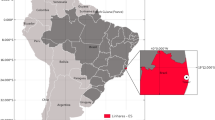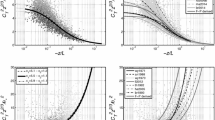Abstract
The spatial resolution of meteorological observations of scalars (such as concentrations or temperature) and scalar fluxes (e.g., water-vapour flux, sensible heat flux) above inhomogeneous surfaces is in general not known. It is determined by the surface area of influence orsource area of the sensor, which for sensors of quantities that are subject to turbulent diffusion, depends on the flow and turbulence conditions.
Functions describing the relationship between the spatial distribution of surface sources (or sinks) and a measured signal at height in the surface layer have been termed thefootprint function or thesource weight function. In this paper, the source area of levelP is defined as the integral of the source weight function over the smallest possible domain comprising the fractionP of the total surface influence reflected in the measured signal. Source area models for scalar concentration and for passive scalar fluxes are presented. The results of the models are presented as characteristic dimensions of theP=50% source areas (i.e., the area responsible for 50% of the surface influence): the maximum source location (i.e., the upwind distance of the surface element with the maximum-weight influence), the near and the far end of the source area, and its maximal lateral extension. These numerical model results are related directly to non-dimensional surface-layer scaling variables by a non-linear least squares method in a parameterized model which provides a user-friendly estimate of the surface area responsible for measured concentrations or fluxes. The source area models presented here allow conclusions to be made about the spatial representativeness and the localness (these terms are defined in the text) of flux and concentration measurements.
Similar content being viewed by others
References
Beljaars, A. C. M., Holtslag, A. A. M., and van Westrhenen, R. M.: 1989,Description of a Software Library for the Calculation of Surface Fluxes, Koninklijk Nederlands Meteorologisch Instituut, De Bilt, Technical Reports, TR 112, 32 p.
Gash, J. H. C.: 1986, ‘A Note on Estimating the Effect of a Limited Fetch on Micrometeorological Evaporation Measurements’,Boundary-Layer Meteorol. 35, 409–414.
Gryning, S. E., Holtslag, A. A. M., Irwin, J. S., and Sivertsen, B.: 1987, ‘Applied Dispersion Modelling Based on Meteorological Scaling Parameters’,Atmos. Environ. 21, 79–89.
Horst, T. W., and Weil, J. C.: 1992, ‘Footprint Estimation for Scalar Flux Measurements in the Atmospheric Surface Layer’,Boundary-Layer Meteorol. 59, 279–296.
Horst, T. W. and Weil, J. C.: 1992, ‘Application of the Flux Footprint to Scalar Flux Measurements within the Atmospheric Surface Layer’,Preprints, 10th Symposium on Turbulence and Diffusion, Portland, Ore., Sept 29–Oct. 2, 1992, Amer. Meteorol. Soc., Boston, Mass., pp. 305–308.
Leclerc, M. Y., Finn, D., and Lamb, B.: 1992, ‘Verification of the Source Footprint Model’,Preprints, 10th Symposium on Turbulence and Diffusion, Portland, Ore., Sept 29–Oct. 2, 1992, Amer. Meteorol. Soc., Boston, Mass., pp. 318–321.
Leclerc, M. Y., and Thurtell, G. W.: 1990, ‘Footprint Predictions of Scalar Fluxes using a Markovian Analysis’,Boundary-Layer Meteorol. 52, 247–258.
Pasquill, F.: 1972, ‘Some Aspects of Boundary Layer Description’,Q. J. R. Meteorol. Soc. 98, 469–494.
Pasquill, F. and Smith, F. B.: 1983,Atmospheric Diffusion, III Ed., J. Wiley & Sons, New York, 437 p.
Press, W. H., Flannery, B. P., Teukolsky, S. A., and Vetterling, W. T.: 1986,Numerical Recipes: the Art of Scientific Computing, Cambridge University Press, Cambridge, 818 p.
Schmid, H. P. and Oke, T. R.: 1990, ‘A Model to Estimate the Source Area Contributing to Turbulent Exchange in the Surface Layer over Patchy Terrain’,Quart. J. Roy. Meteorol. Soc. 116, 965–988.
Schmid, H. P., Cleugh, H. A., Grimmond, C. S. B., and Oke, T. R.: 1991, ‘Spatial Variability of Energy Fluxes in Suburban Terrain’,Boundary-Layer Meteorol. 54, 249–276.
Schmid, H. P. and Oke, T. R.: 1988, ‘Estimating the Source Area of a Turbulent Flux Measurement over a Patchy Surface’,Preprints, 8th Symposium on Turbulence and Diffusion, San Diego, Ca., April 26–29, 1988, Amer. Meteorol. Soc., Boston, Mass, pp. 123–126.
Schuepp, P. H., Leclerc, M. Y., McPherson, J. I., and Desjardin, R. L.: 1990, ‘Footprint Prediction of Scalar Fluxes from Analytical Solutions of the Diffusion Equation’,Boundary-Layer Meteorol. 50, 355–374.
Van Ulden, A. P.: 1978, ‘Simple Estimates for Vertical Diffusion from Sources near the Ground’,Atmos. Environ. 12, 2125–2129.
Willmott, C. J.: 1981, ‘On the Validation of Models’,Phys. Geogr. 2, 184–194.
Wilson, J. D. and Swaters, G. E.: 1991, ‘The Source Area Influencing a Measurement in the Planetary Boundary Layer: The “Footprint” and the “Distribution of Contact Distance”’,Boundary-Layer Meteorol. 55, 25–46.
Author information
Authors and Affiliations
Rights and permissions
About this article
Cite this article
Schmid, H.P. Source areas for scalars and scalar fluxes. Boundary-Layer Meteorol 67, 293–318 (1994). https://doi.org/10.1007/BF00713146
Revised:
Issue Date:
DOI: https://doi.org/10.1007/BF00713146




